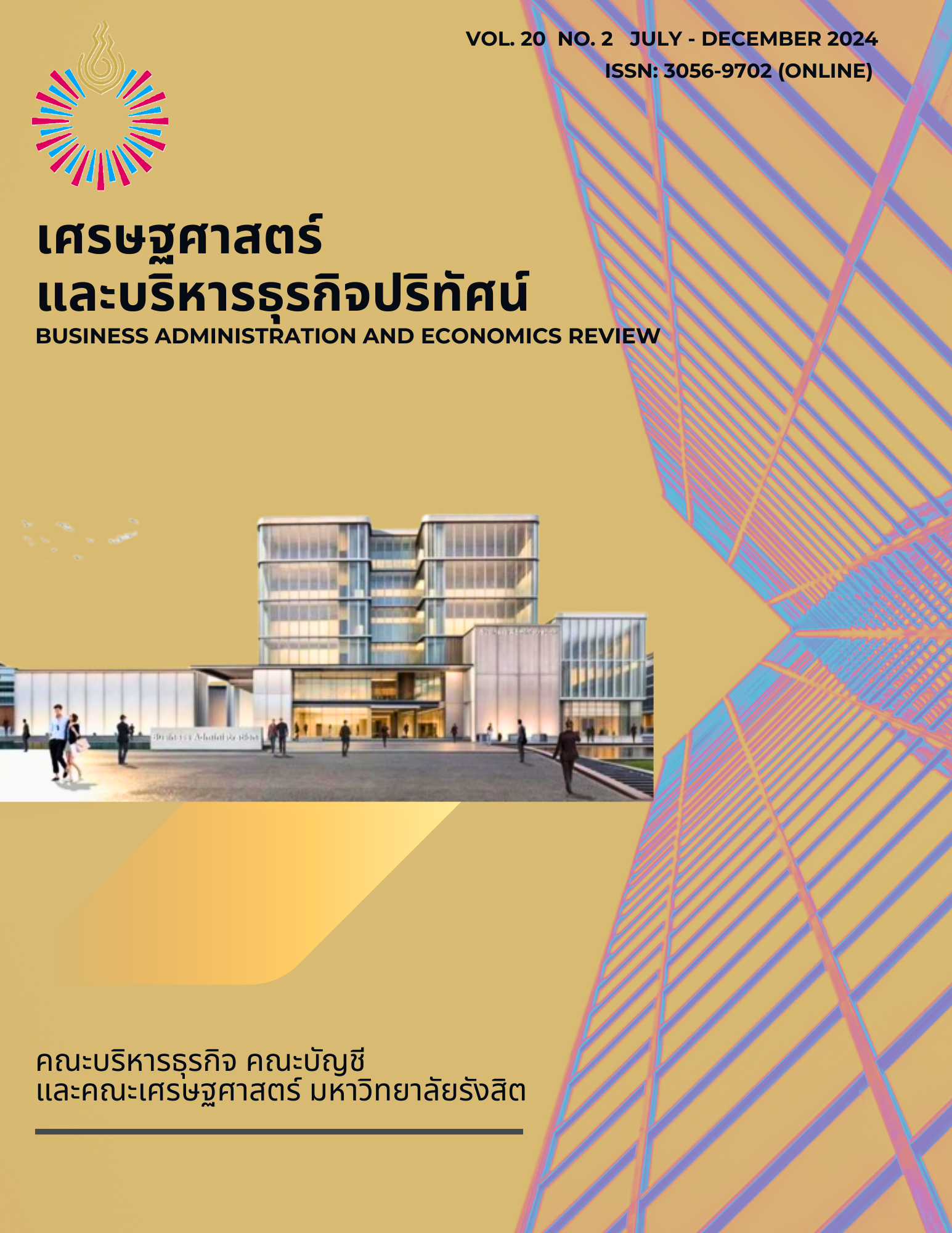เศรษฐศาสตร์อาชญากรรมไซเบอร์: สถานะองค์ความรู้และการวิจัยในอนาคต
คำสำคัญ:
เศรษฐศาสตร์อาชญากรรมไซเบอร์, ความปลอดภัยทางไซเบอร์, เศรษฐกิจบทคัดย่อ
อาชญากรรมทางไซเบอร์เป็นภัยคุกคามที่สำคัญต่อเศรษฐกิจ ความมั่นคง และความเป็นอยู่ของสังคมไทย ปัจจัยทางเศรษฐกิจ เช่น ความเหลื่อมล้ำทางรายได้ ความยากจน และการว่างงาน เป็นตัวขับเคลื่อนหลักที่ผลักดันให้คนหันไปสู่อาชญากรรมทางไซเบอร์ โดยเฉพาะในกลุ่มผู้มีรายได้น้อยที่มองว่าเป็นวิธีหนึ่งในการสร้างความมั่นคงทางการเงิน การศึกษาแม้จะช่วยลดอัตราอาชญากรรม แต่เมื่อผนวกกับทักษะทางเทคนิคก็อาจนำไปสู่การโจมตีทางไซเบอร์ที่ซับซ้อนได้ ความก้าวหน้าทางเทคโนโลยี แม้จะช่วยเพิ่มการเติบโตทางเศรษฐกิจ แต่ก็เปิดช่องทางใหม่ให้อาชญากรทางไซเบอร์ ประเทศไทยมีความเสี่ยงสูงจากการใช้อินเทอร์เน็ตอย่างแพร่หลาย การเชื่อมต่อบรอดแบนด์ที่รวดเร็ว และระดับความรู้ทางเทคโนโลยีที่แตกต่างกัน แม้จะมีกฎหมายความปลอดภัยทางไซเบอร์และการจัดตั้งหน่วยงานบังคับใช้เฉพาะทางแล้ว แต่ความท้าทายยังคงมีอยู่เนื่องจากภัยคุกคามที่เปลี่ยนแปลงตลอดเวลา ผลกระทบทางเศรษฐกิจจากอาชญากรรมทางไซเบอร์ในไทยนั้นรุนแรง นำไปสู่การสูญเสียทางการเงินครั้งใหญ่ ลดการลงทุนจากต่างประเทศ และลดความเชื่อมั่นในแพลตฟอร์มดิจิทัล เพื่อรับมืออย่างมีประสิทธิภาพ จำเป็นต้องมีการวิจัยเพิ่มเติมเกี่ยวกับตัวขับเคลื่อนทางเศรษฐกิจและเทคโนโลยีของอาชญากรรมทางไซเบอร์ และการสร้างความร่วมมือระหว่างประเทศเพื่อสร้างอนาคตดิจิทัลที่ปลอดภัยสำหรับประเทศไทย
เอกสารอ้างอิง
Bukrapue, P. (2015). Fraudulent activities against foreign tourists in Thailand: A case study of
jewelry business. International Journal of Criminal Justice Sciences, 10(165).
Calderwood, F., & Popova, I. (2018). Smartphone cyber security awareness in developing
countries: A case of Thailand. In Digital Forensics and Cyber Crime (pp. 79-86). Springer, Cham.
Calderwood, F., & Popova, I. (2018). Smartphone cyber security awareness in developing
countries: A case of Thailand. In Proceedings of the 2018 International Conference on Information
and Communication Technology for Development (ICT4D).
Chotewetsin, P. (2023). Political risk factors affecting the economy of Thailand. SSRN
Electronic Journal. https://doi.org/10.2139/ssrn.1234567
Dearden, T. E., Parti, K., & Hawdon, J. (2021). Institutional Anomie Theory and Cybercrime—
Cybercrime and the American Dream, Now Available Online. Journal of Contemporary Criminal
Justice, 37(3), 311-332. https://doi.org/10.1177/1043986221991234
Emerald Expert Briefings. (2018). Thailand firms up Asian trend on cybersecurity rules.
Emerald Insight.
Financial Crime News. (2024). Thailand Country Financial Crime Dashboard 2024. Retrieved
from https://www.financialcrimenews.com
Kraiwanit, T., & Srijaem, P. (2021). Evaluation of Internet Transaction Fraud in Thailand. SSRN
Electronic Journal. https://doi.org/10.2139/ssrn.1234568
Kshetri, N. (2006). The simple economics of cybercrimes. IEEE Security & Privacy Magazine,
(1), 33-39. https://doi.org/10.1109/MSP.2006.4
Kshetri, N. (2013). Cybercrime and Cybersecurity in the Global South: Status, Drivers and
Trends. In The Global Cybercrime Industry (pp. 1-29). Palgrave Macmillan, London.
Leukfeldt, E. R., & Yar, M. (2016). Applying Routine Activity Theory to Cybercrime: A
Theoretical and Empirical Analysis. Deviant Behavior, 37(3), 263-280. https://doi.org/10.1080/01639625.2015.1012409
Machim, K., Jariyapoom, T., & Pornpundejwittaya, P. (2020). Guidelines for the protection of
computer crime threats in the industrial business. Academy of Strategic Management Journal, 19.
OpenGov Asia. (2024). Thailand's strategies to combat cybercrime. Retrieved from
https://www.opengovasia.com/thailands-strategies-to-combat-cybercrime/
Park, J., Cho, D., Lee, J. K., & Lee, B. (2019). The economics of cybercrime. ACM Transactions
on Management Information Systems (TMIS), 10(1-23). https://doi.org/10.1145/3290531
Riek, M., Böhme, R., & Moore, T. (2016). Measuring the influence of perceived cybercrime risk
on online service avoidance. IEEE Transactions on Dependable and Secure Computing,
(261-273). https://doi.org/10.1109/TDSC.2015.2438521
Rogers, M. (2011). The psyche of cybercriminals: A psycho-social perspective. In Psychology
of Cybercrime.
Rungsrisawat, S., Jermsittiparsert, K., & Thanetpaksapong, S. (2019). Do the crime and the
socioeconomic strain affects economic growth? A case of an emerging ASEAN economy. Journal of Security and Sustainability Issues, 9(391-407). https://doi.org/10.9770/jssi.2019.9.3(9)
Siahaan, A. (2018). Impact of cybercrime on technological and financial developments. SSRN
Electronic Journal. https://doi.org/10.2139/ssrn.1234570
Stalans, L., & Donner, C. M. (2018). Explaining why cybercrime occurs: Criminological and
psychological theories. In Understanding Cybercrime.
Ter, K. L. (2017). Combating cybercrime in Singapore. TIJ's Research Journal of Social Science
& Management - RJSSM, 7.
Thai Examiner. (2024). Campaign to fight cybercrime in Thailand. Retrieved from
Thaiger. (2024). Latest crime news in Thailand. Retrieved from https://www.thethaiger.com
Tilleke & Gibbins. (2024). Thailand's new cybercrime measures enlist aid of banks and service
providers. Retrieved from https://www.tilleke.com/insights/thailands-new-cybercrime-measures-enlist-aid-of-banks-and-service-providers/
Tilleke & Gibbins. (2024). Thailand establishes a technology crime court. Retrieved from
https://www.mondaq.com/thailand/crime/1302912
Worldmetrics. (2024). Thailand Crime Rate Statistics: Market Data Report 2024. Retrieved

ดาวน์โหลด
เผยแพร่แล้ว
รูปแบบการอ้างอิง
ฉบับ
ประเภทบทความ
สัญญาอนุญาต
ลิขสิทธิ์ (c) 2024 เศรษฐศาสตร์และบริหารธุรกิจปริทัศน์

อนุญาตภายใต้เงื่อนไข Creative Commons Attribution-NonCommercial-NoDerivatives 4.0 International License.
เนื้อหาในวารสารเศรษฐศาสตร์และบริหารธุรกิจปริทัศน์ สามารถนำผลงานไปใช้เผยแพร่ได้ แต่ห้ามนำไปแก้ไข ดัดแปลง หรือนำไปใช้ทางการค้าและแสวงหาผลกำไร

